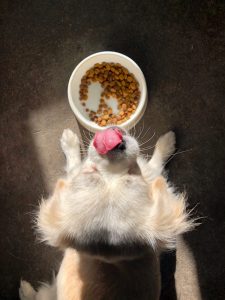How is dry pet food made?
Pet owners might have often wondered how the tasty food their beloved animal enjoys every day is made. In this article we’re going to do a breakdown of each step of the pet food production process to provide a deeper insight into how pet food goes from the factory to the food bowl.
Overview
Dry pet foods are typically made by combining wet and dry ingredients together to create a dough. During the extrusion process, the dough is then heated under pressure and pushed through a die machine that cuts the food into the kibbles.
The shape and size of the kibbles can vary depending on the product specification. To finish off the process the kibbles are dried, cooled, and spray coated. Certain dry foods might also be manufactured in a different way to extrusion, such as baking.

Selecting and sourcing ingredients
A lot of the ingredients in pet food engineering are described as being derived from animals (or fish) or as by-products. Often these ingredients are the parts of the animal that are not required by the human food industry.
In dry pet foods, animal derivatives are mostly used in the form of a meal (e.g., chicken meal, poultry by-product meal). This is where meat derivatives are cooked, the fat is removed, and the rest of the ingredient is dried to produce a dry pet meal. By-products can be used either fresh or frozen.
Most of the other ingredients like grains come in dry form and are milled or ground before everything is combined. A standard dry pet food recipe will also likely contain oils and fats, vitamins, and materials, which are needed to ensure the product provides all the important nutrients to household pets.
Weighing and preparing ingredients
There are a wide range of possibilities when it comes to creating pet food. That’s why ingredients are carefully chosen in accordance with the manufacturer’s specific recipe, formulated to deliver complete and well-balanced nutrition for dogs and cats. Dry ingredients are ground, sieved where needed, and then mixed.

Cooking and cooling the dry food
When it is time to cook the food, the dry mix is added to the wet ingredients and steamed in a pre-conditioner. This will hydrate the dry powders and help to form a dough which begins the cooking procedure.
Following this, the dough goes into a machine known as an extruder, which adds a large amount of pressure to cook the dough. The dough then comes out of the extruder via a die plate that creates ribbons of pre-specified shapes which are then sliced into the desired size using a rotary cutter.
After the extrusion and being cut into the required shapes, the kibbles are air dried in an oven to take away any moisture and then cooled. Minimising how much moisture in the food is a key element that helps to maintain the food’s freshness and stop it from spoiling.
If the pet food production is done by baking, the dough is rolled out and cut into shapes and then baked in an oven (in a similar way to biscuits or cookies).
Coating the kibble
After they have been dried and cooled, the kibbles are then added to a rotating drum where they get evenly coated in a mix of flavours to enhance the taste and preservatives. This stops the food from spoiling during its shelf life. Flavours or other coatings can be sprayed onto baked pet foods when they are taken out of the oven.
Packaging the food
Dry pet food packs are filled according to the manufacturer’s declared weight of the product. The packaging is suitably and securely sealed to prevent contamination.
Storage and distribution
Packages are kept in boxes or wrapped on pallets in warehouses ready to be sent to customers.
Your pet food factory consultant
At FESS Group, our factory set up consultants are here to help you organise your food engineering operations to abide by certain standards and the strict regulations that are in place for pet food production. Setting up a production line for pet food can be tricky. So, to ensure everything is done correctly with no money or resources wasted you could benefit from working with one of our pet food factory consultants. Contact us today to find out more about our helpful services.